Entrepreneurship and Small Business Management Case Study 2022
VerifiedAdded on 2022/09/15
|6
|1376
|20
AI Summary
Contribute Materials
Your contribution can guide someone’s learning journey. Share your
documents today.
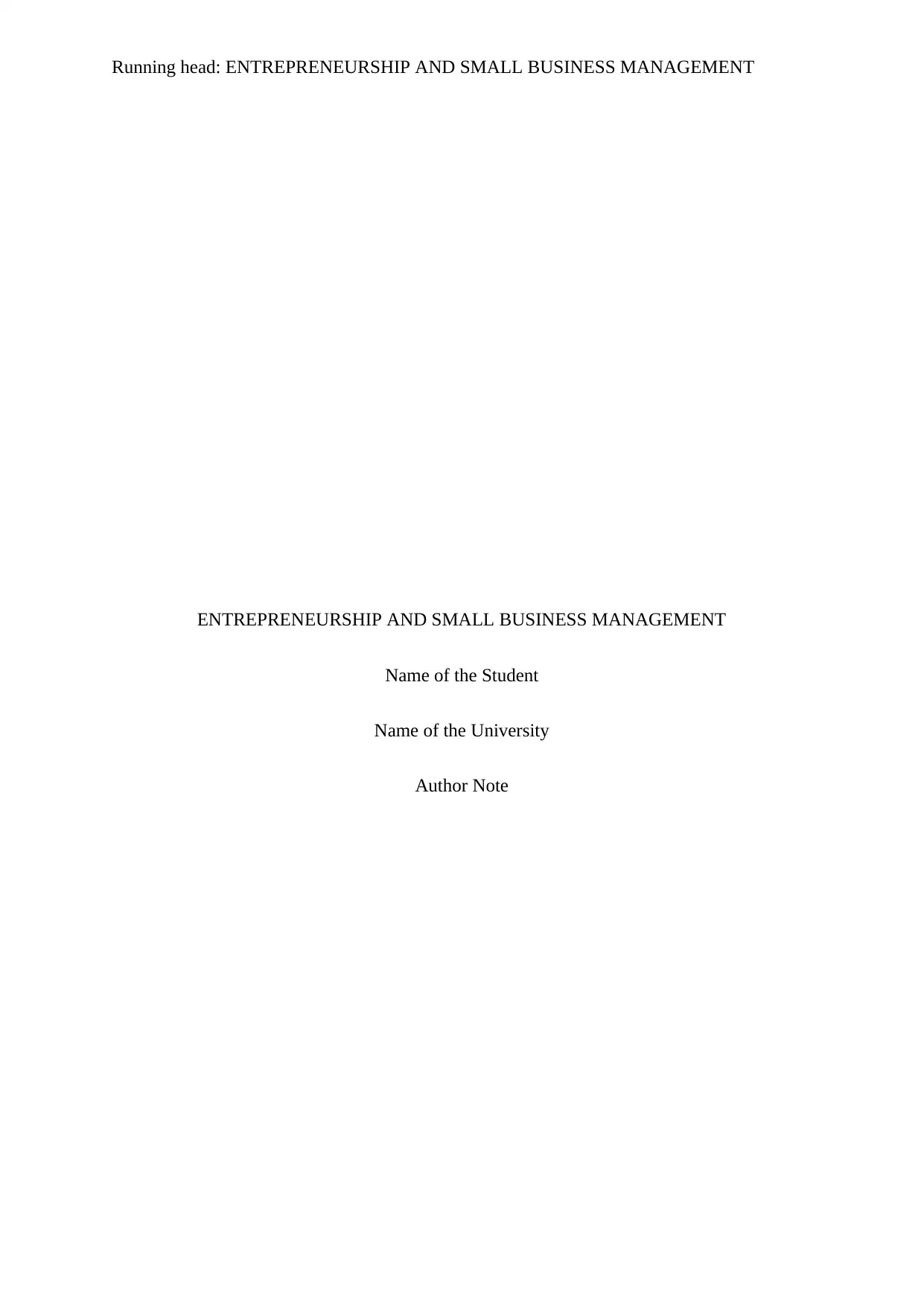
Running head: ENTREPRENEURSHIP AND SMALL BUSINESS MANAGEMENT
ENTREPRENEURSHIP AND SMALL BUSINESS MANAGEMENT
Name of the Student
Name of the University
Author Note
ENTREPRENEURSHIP AND SMALL BUSINESS MANAGEMENT
Name of the Student
Name of the University
Author Note
Secure Best Marks with AI Grader
Need help grading? Try our AI Grader for instant feedback on your assignments.
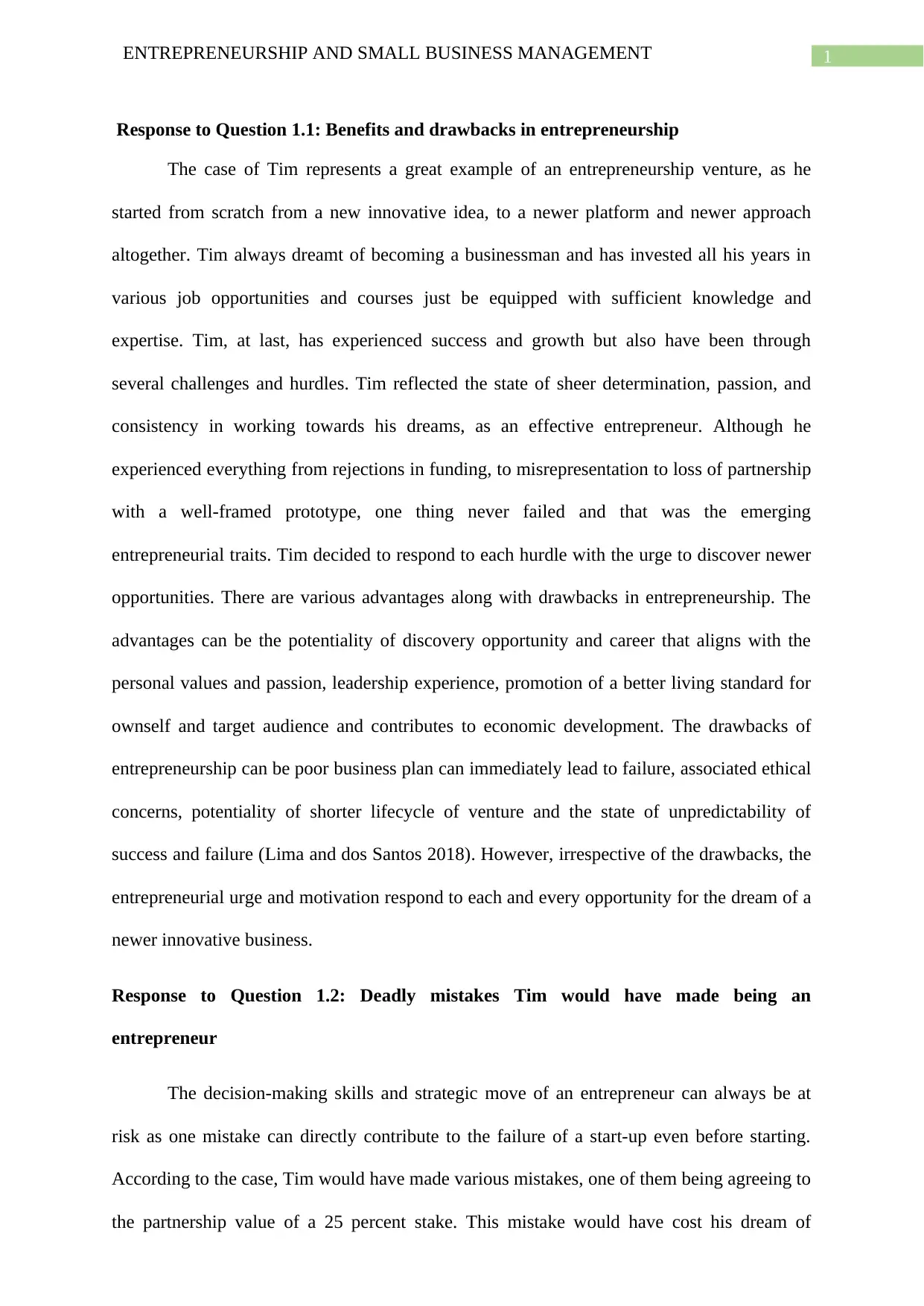
1ENTREPRENEURSHIP AND SMALL BUSINESS MANAGEMENT
Response to Question 1.1: Benefits and drawbacks in entrepreneurship
The case of Tim represents a great example of an entrepreneurship venture, as he
started from scratch from a new innovative idea, to a newer platform and newer approach
altogether. Tim always dreamt of becoming a businessman and has invested all his years in
various job opportunities and courses just be equipped with sufficient knowledge and
expertise. Tim, at last, has experienced success and growth but also have been through
several challenges and hurdles. Tim reflected the state of sheer determination, passion, and
consistency in working towards his dreams, as an effective entrepreneur. Although he
experienced everything from rejections in funding, to misrepresentation to loss of partnership
with a well-framed prototype, one thing never failed and that was the emerging
entrepreneurial traits. Tim decided to respond to each hurdle with the urge to discover newer
opportunities. There are various advantages along with drawbacks in entrepreneurship. The
advantages can be the potentiality of discovery opportunity and career that aligns with the
personal values and passion, leadership experience, promotion of a better living standard for
ownself and target audience and contributes to economic development. The drawbacks of
entrepreneurship can be poor business plan can immediately lead to failure, associated ethical
concerns, potentiality of shorter lifecycle of venture and the state of unpredictability of
success and failure (Lima and dos Santos 2018). However, irrespective of the drawbacks, the
entrepreneurial urge and motivation respond to each and every opportunity for the dream of a
newer innovative business.
Response to Question 1.2: Deadly mistakes Tim would have made being an
entrepreneur
The decision-making skills and strategic move of an entrepreneur can always be at
risk as one mistake can directly contribute to the failure of a start-up even before starting.
According to the case, Tim would have made various mistakes, one of them being agreeing to
the partnership value of a 25 percent stake. This mistake would have cost his dream of
Response to Question 1.1: Benefits and drawbacks in entrepreneurship
The case of Tim represents a great example of an entrepreneurship venture, as he
started from scratch from a new innovative idea, to a newer platform and newer approach
altogether. Tim always dreamt of becoming a businessman and has invested all his years in
various job opportunities and courses just be equipped with sufficient knowledge and
expertise. Tim, at last, has experienced success and growth but also have been through
several challenges and hurdles. Tim reflected the state of sheer determination, passion, and
consistency in working towards his dreams, as an effective entrepreneur. Although he
experienced everything from rejections in funding, to misrepresentation to loss of partnership
with a well-framed prototype, one thing never failed and that was the emerging
entrepreneurial traits. Tim decided to respond to each hurdle with the urge to discover newer
opportunities. There are various advantages along with drawbacks in entrepreneurship. The
advantages can be the potentiality of discovery opportunity and career that aligns with the
personal values and passion, leadership experience, promotion of a better living standard for
ownself and target audience and contributes to economic development. The drawbacks of
entrepreneurship can be poor business plan can immediately lead to failure, associated ethical
concerns, potentiality of shorter lifecycle of venture and the state of unpredictability of
success and failure (Lima and dos Santos 2018). However, irrespective of the drawbacks, the
entrepreneurial urge and motivation respond to each and every opportunity for the dream of a
newer innovative business.
Response to Question 1.2: Deadly mistakes Tim would have made being an
entrepreneur
The decision-making skills and strategic move of an entrepreneur can always be at
risk as one mistake can directly contribute to the failure of a start-up even before starting.
According to the case, Tim would have made various mistakes, one of them being agreeing to
the partnership value of a 25 percent stake. This mistake would have cost his dream of
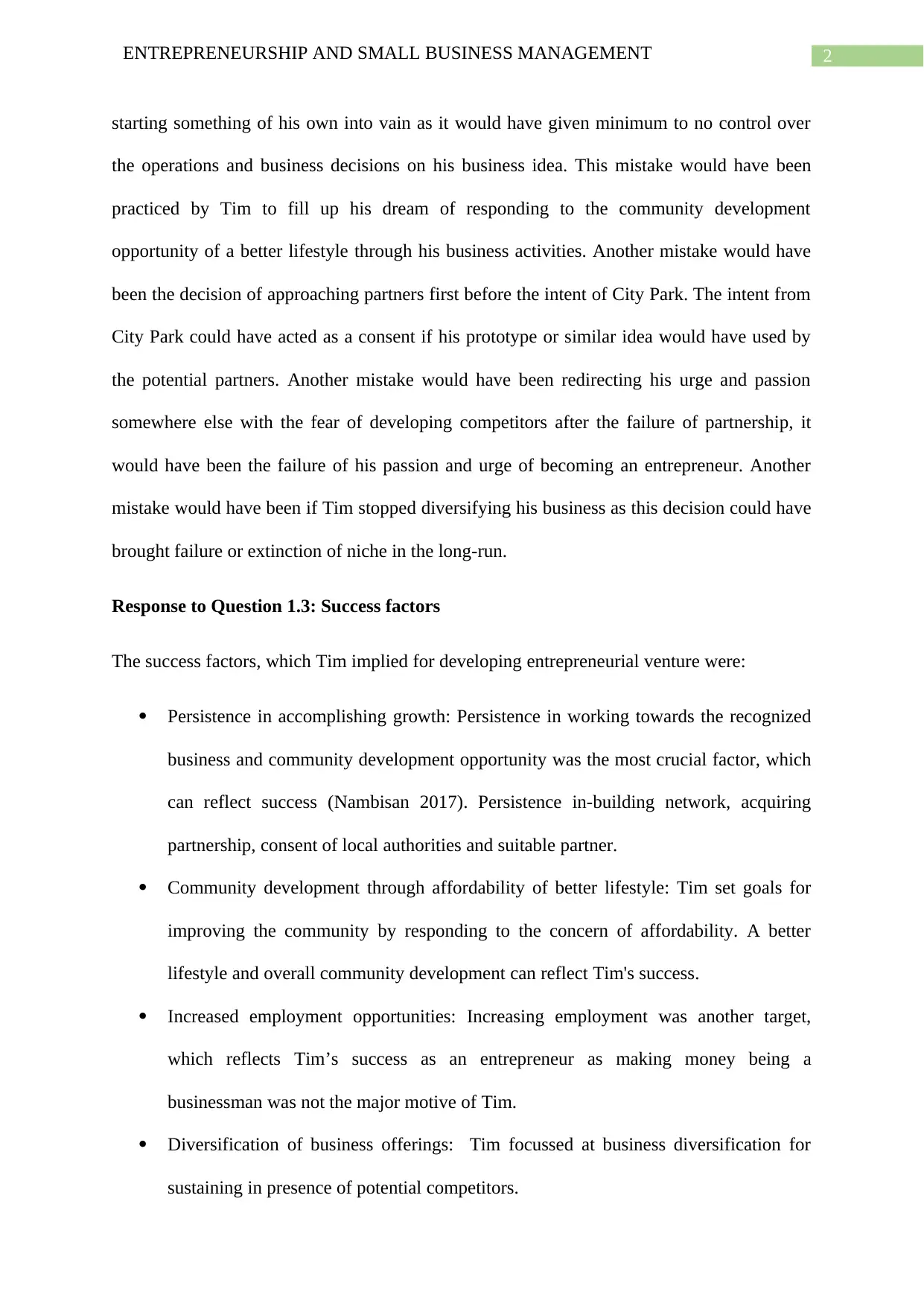
2ENTREPRENEURSHIP AND SMALL BUSINESS MANAGEMENT
starting something of his own into vain as it would have given minimum to no control over
the operations and business decisions on his business idea. This mistake would have been
practiced by Tim to fill up his dream of responding to the community development
opportunity of a better lifestyle through his business activities. Another mistake would have
been the decision of approaching partners first before the intent of City Park. The intent from
City Park could have acted as a consent if his prototype or similar idea would have used by
the potential partners. Another mistake would have been redirecting his urge and passion
somewhere else with the fear of developing competitors after the failure of partnership, it
would have been the failure of his passion and urge of becoming an entrepreneur. Another
mistake would have been if Tim stopped diversifying his business as this decision could have
brought failure or extinction of niche in the long-run.
Response to Question 1.3: Success factors
The success factors, which Tim implied for developing entrepreneurial venture were:
Persistence in accomplishing growth: Persistence in working towards the recognized
business and community development opportunity was the most crucial factor, which
can reflect success (Nambisan 2017). Persistence in-building network, acquiring
partnership, consent of local authorities and suitable partner.
Community development through affordability of better lifestyle: Tim set goals for
improving the community by responding to the concern of affordability. A better
lifestyle and overall community development can reflect Tim's success.
Increased employment opportunities: Increasing employment was another target,
which reflects Tim’s success as an entrepreneur as making money being a
businessman was not the major motive of Tim.
Diversification of business offerings: Tim focussed at business diversification for
sustaining in presence of potential competitors.
starting something of his own into vain as it would have given minimum to no control over
the operations and business decisions on his business idea. This mistake would have been
practiced by Tim to fill up his dream of responding to the community development
opportunity of a better lifestyle through his business activities. Another mistake would have
been the decision of approaching partners first before the intent of City Park. The intent from
City Park could have acted as a consent if his prototype or similar idea would have used by
the potential partners. Another mistake would have been redirecting his urge and passion
somewhere else with the fear of developing competitors after the failure of partnership, it
would have been the failure of his passion and urge of becoming an entrepreneur. Another
mistake would have been if Tim stopped diversifying his business as this decision could have
brought failure or extinction of niche in the long-run.
Response to Question 1.3: Success factors
The success factors, which Tim implied for developing entrepreneurial venture were:
Persistence in accomplishing growth: Persistence in working towards the recognized
business and community development opportunity was the most crucial factor, which
can reflect success (Nambisan 2017). Persistence in-building network, acquiring
partnership, consent of local authorities and suitable partner.
Community development through affordability of better lifestyle: Tim set goals for
improving the community by responding to the concern of affordability. A better
lifestyle and overall community development can reflect Tim's success.
Increased employment opportunities: Increasing employment was another target,
which reflects Tim’s success as an entrepreneur as making money being a
businessman was not the major motive of Tim.
Diversification of business offerings: Tim focussed at business diversification for
sustaining in presence of potential competitors.
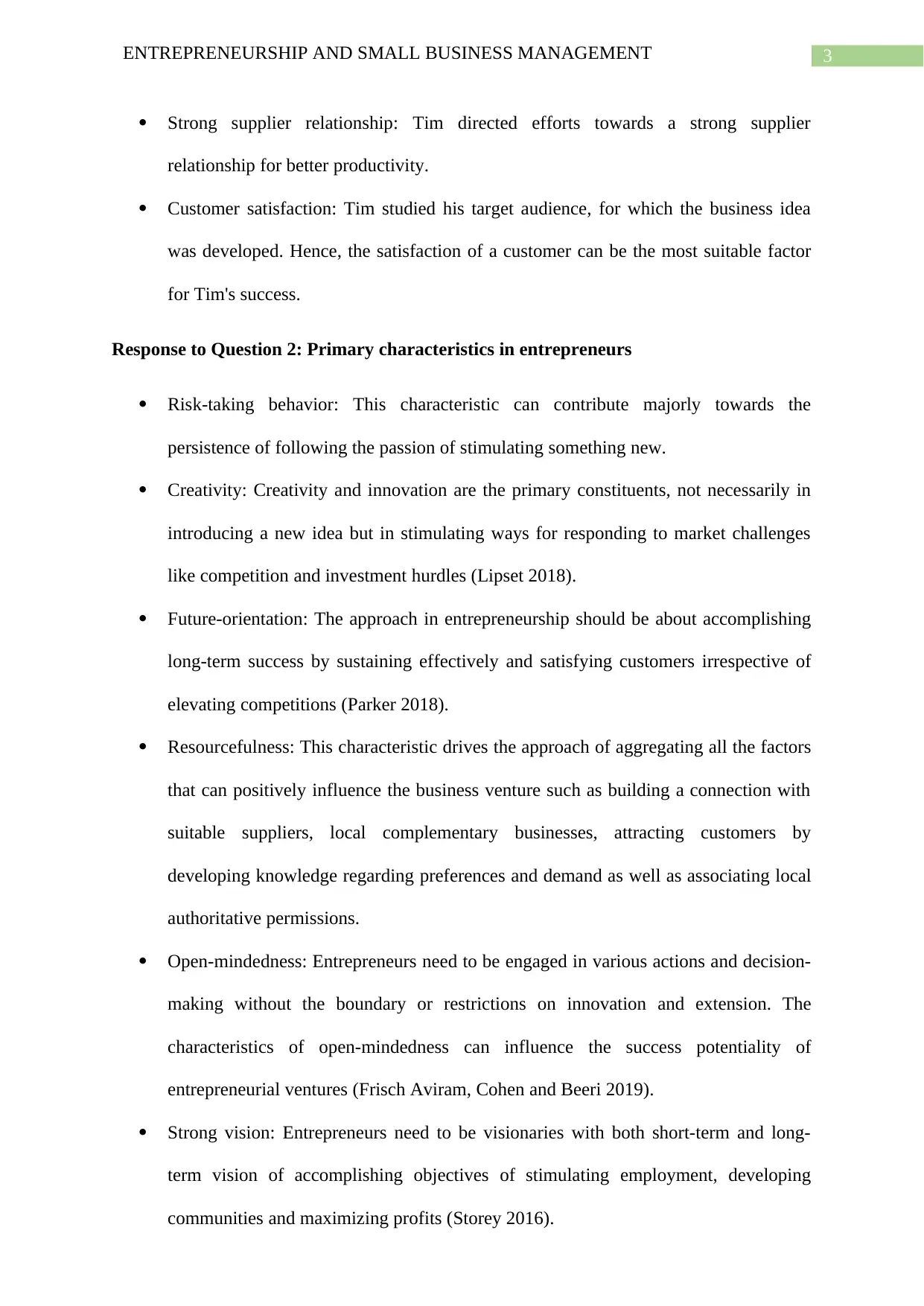
3ENTREPRENEURSHIP AND SMALL BUSINESS MANAGEMENT
Strong supplier relationship: Tim directed efforts towards a strong supplier
relationship for better productivity.
Customer satisfaction: Tim studied his target audience, for which the business idea
was developed. Hence, the satisfaction of a customer can be the most suitable factor
for Tim's success.
Response to Question 2: Primary characteristics in entrepreneurs
Risk-taking behavior: This characteristic can contribute majorly towards the
persistence of following the passion of stimulating something new.
Creativity: Creativity and innovation are the primary constituents, not necessarily in
introducing a new idea but in stimulating ways for responding to market challenges
like competition and investment hurdles (Lipset 2018).
Future-orientation: The approach in entrepreneurship should be about accomplishing
long-term success by sustaining effectively and satisfying customers irrespective of
elevating competitions (Parker 2018).
Resourcefulness: This characteristic drives the approach of aggregating all the factors
that can positively influence the business venture such as building a connection with
suitable suppliers, local complementary businesses, attracting customers by
developing knowledge regarding preferences and demand as well as associating local
authoritative permissions.
Open-mindedness: Entrepreneurs need to be engaged in various actions and decision-
making without the boundary or restrictions on innovation and extension. The
characteristics of open-mindedness can influence the success potentiality of
entrepreneurial ventures (Frisch Aviram, Cohen and Beeri 2019).
Strong vision: Entrepreneurs need to be visionaries with both short-term and long-
term vision of accomplishing objectives of stimulating employment, developing
communities and maximizing profits (Storey 2016).
Strong supplier relationship: Tim directed efforts towards a strong supplier
relationship for better productivity.
Customer satisfaction: Tim studied his target audience, for which the business idea
was developed. Hence, the satisfaction of a customer can be the most suitable factor
for Tim's success.
Response to Question 2: Primary characteristics in entrepreneurs
Risk-taking behavior: This characteristic can contribute majorly towards the
persistence of following the passion of stimulating something new.
Creativity: Creativity and innovation are the primary constituents, not necessarily in
introducing a new idea but in stimulating ways for responding to market challenges
like competition and investment hurdles (Lipset 2018).
Future-orientation: The approach in entrepreneurship should be about accomplishing
long-term success by sustaining effectively and satisfying customers irrespective of
elevating competitions (Parker 2018).
Resourcefulness: This characteristic drives the approach of aggregating all the factors
that can positively influence the business venture such as building a connection with
suitable suppliers, local complementary businesses, attracting customers by
developing knowledge regarding preferences and demand as well as associating local
authoritative permissions.
Open-mindedness: Entrepreneurs need to be engaged in various actions and decision-
making without the boundary or restrictions on innovation and extension. The
characteristics of open-mindedness can influence the success potentiality of
entrepreneurial ventures (Frisch Aviram, Cohen and Beeri 2019).
Strong vision: Entrepreneurs need to be visionaries with both short-term and long-
term vision of accomplishing objectives of stimulating employment, developing
communities and maximizing profits (Storey 2016).
Secure Best Marks with AI Grader
Need help grading? Try our AI Grader for instant feedback on your assignments.
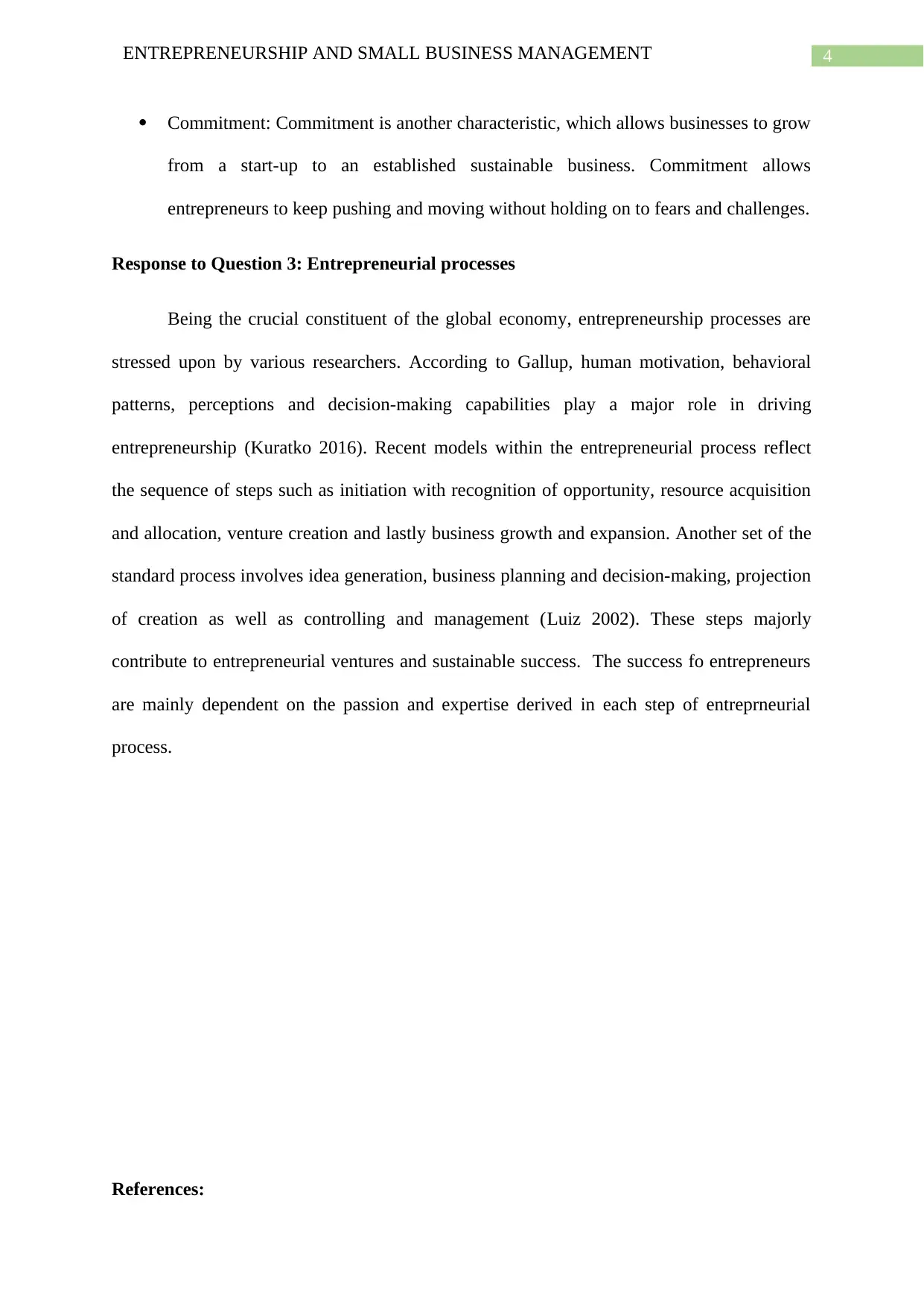
4ENTREPRENEURSHIP AND SMALL BUSINESS MANAGEMENT
Commitment: Commitment is another characteristic, which allows businesses to grow
from a start-up to an established sustainable business. Commitment allows
entrepreneurs to keep pushing and moving without holding on to fears and challenges.
Response to Question 3: Entrepreneurial processes
Being the crucial constituent of the global economy, entrepreneurship processes are
stressed upon by various researchers. According to Gallup, human motivation, behavioral
patterns, perceptions and decision-making capabilities play a major role in driving
entrepreneurship (Kuratko 2016). Recent models within the entrepreneurial process reflect
the sequence of steps such as initiation with recognition of opportunity, resource acquisition
and allocation, venture creation and lastly business growth and expansion. Another set of the
standard process involves idea generation, business planning and decision-making, projection
of creation as well as controlling and management (Luiz 2002). These steps majorly
contribute to entrepreneurial ventures and sustainable success. The success fo entrepreneurs
are mainly dependent on the passion and expertise derived in each step of entreprneurial
process.
References:
Commitment: Commitment is another characteristic, which allows businesses to grow
from a start-up to an established sustainable business. Commitment allows
entrepreneurs to keep pushing and moving without holding on to fears and challenges.
Response to Question 3: Entrepreneurial processes
Being the crucial constituent of the global economy, entrepreneurship processes are
stressed upon by various researchers. According to Gallup, human motivation, behavioral
patterns, perceptions and decision-making capabilities play a major role in driving
entrepreneurship (Kuratko 2016). Recent models within the entrepreneurial process reflect
the sequence of steps such as initiation with recognition of opportunity, resource acquisition
and allocation, venture creation and lastly business growth and expansion. Another set of the
standard process involves idea generation, business planning and decision-making, projection
of creation as well as controlling and management (Luiz 2002). These steps majorly
contribute to entrepreneurial ventures and sustainable success. The success fo entrepreneurs
are mainly dependent on the passion and expertise derived in each step of entreprneurial
process.
References:
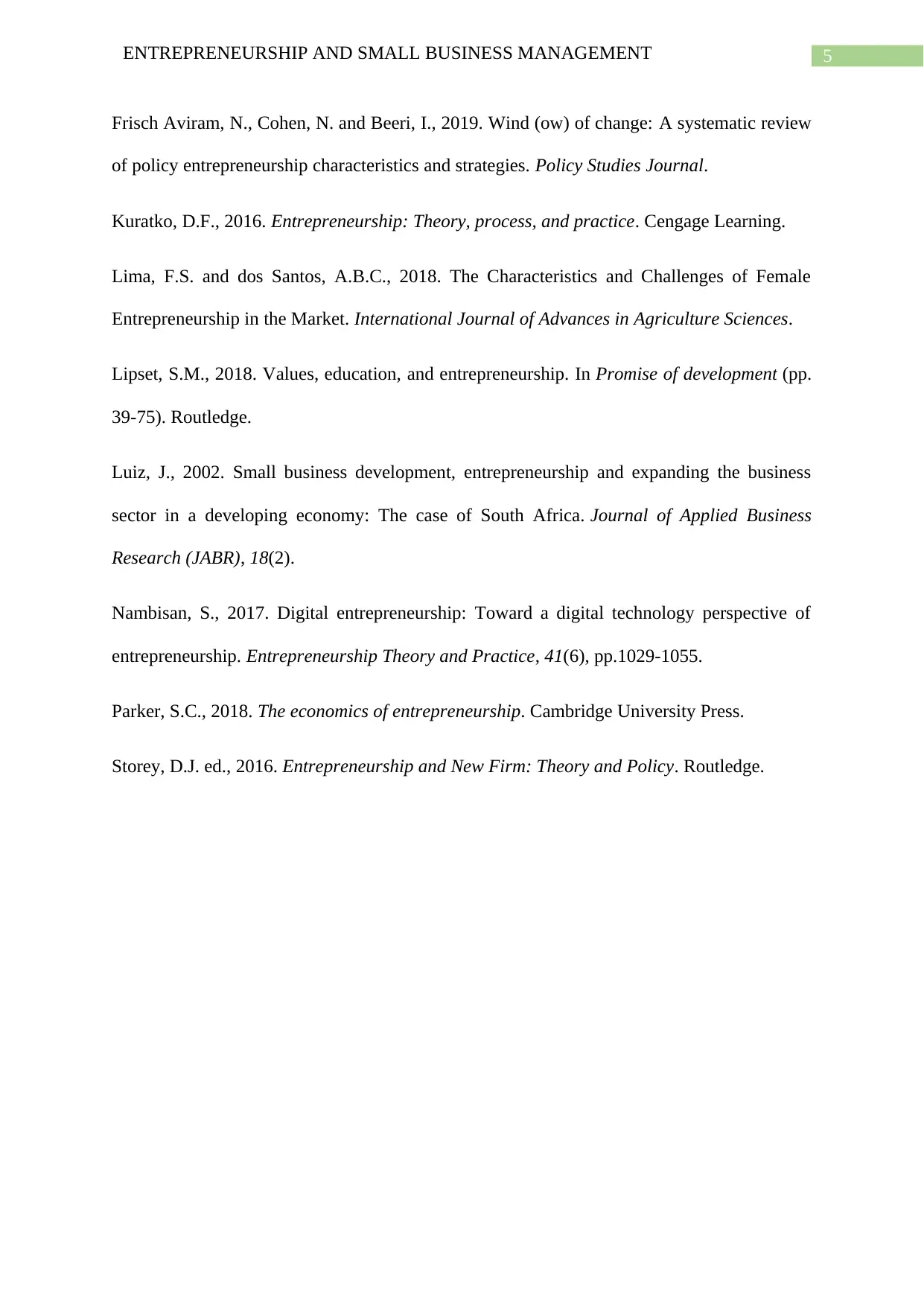
5ENTREPRENEURSHIP AND SMALL BUSINESS MANAGEMENT
Frisch Aviram, N., Cohen, N. and Beeri, I., 2019. Wind (ow) of change: A systematic review
of policy entrepreneurship characteristics and strategies. Policy Studies Journal.
Kuratko, D.F., 2016. Entrepreneurship: Theory, process, and practice. Cengage Learning.
Lima, F.S. and dos Santos, A.B.C., 2018. The Characteristics and Challenges of Female
Entrepreneurship in the Market. International Journal of Advances in Agriculture Sciences.
Lipset, S.M., 2018. Values, education, and entrepreneurship. In Promise of development (pp.
39-75). Routledge.
Luiz, J., 2002. Small business development, entrepreneurship and expanding the business
sector in a developing economy: The case of South Africa. Journal of Applied Business
Research (JABR), 18(2).
Nambisan, S., 2017. Digital entrepreneurship: Toward a digital technology perspective of
entrepreneurship. Entrepreneurship Theory and Practice, 41(6), pp.1029-1055.
Parker, S.C., 2018. The economics of entrepreneurship. Cambridge University Press.
Storey, D.J. ed., 2016. Entrepreneurship and New Firm: Theory and Policy. Routledge.
Frisch Aviram, N., Cohen, N. and Beeri, I., 2019. Wind (ow) of change: A systematic review
of policy entrepreneurship characteristics and strategies. Policy Studies Journal.
Kuratko, D.F., 2016. Entrepreneurship: Theory, process, and practice. Cengage Learning.
Lima, F.S. and dos Santos, A.B.C., 2018. The Characteristics and Challenges of Female
Entrepreneurship in the Market. International Journal of Advances in Agriculture Sciences.
Lipset, S.M., 2018. Values, education, and entrepreneurship. In Promise of development (pp.
39-75). Routledge.
Luiz, J., 2002. Small business development, entrepreneurship and expanding the business
sector in a developing economy: The case of South Africa. Journal of Applied Business
Research (JABR), 18(2).
Nambisan, S., 2017. Digital entrepreneurship: Toward a digital technology perspective of
entrepreneurship. Entrepreneurship Theory and Practice, 41(6), pp.1029-1055.
Parker, S.C., 2018. The economics of entrepreneurship. Cambridge University Press.
Storey, D.J. ed., 2016. Entrepreneurship and New Firm: Theory and Policy. Routledge.
1 out of 6
Related Documents
Your All-in-One AI-Powered Toolkit for Academic Success.
+13062052269
info@desklib.com
Available 24*7 on WhatsApp / Email
![[object Object]](/_next/static/media/star-bottom.7253800d.svg)
Unlock your academic potential
© 2024 | Zucol Services PVT LTD | All rights reserved.





